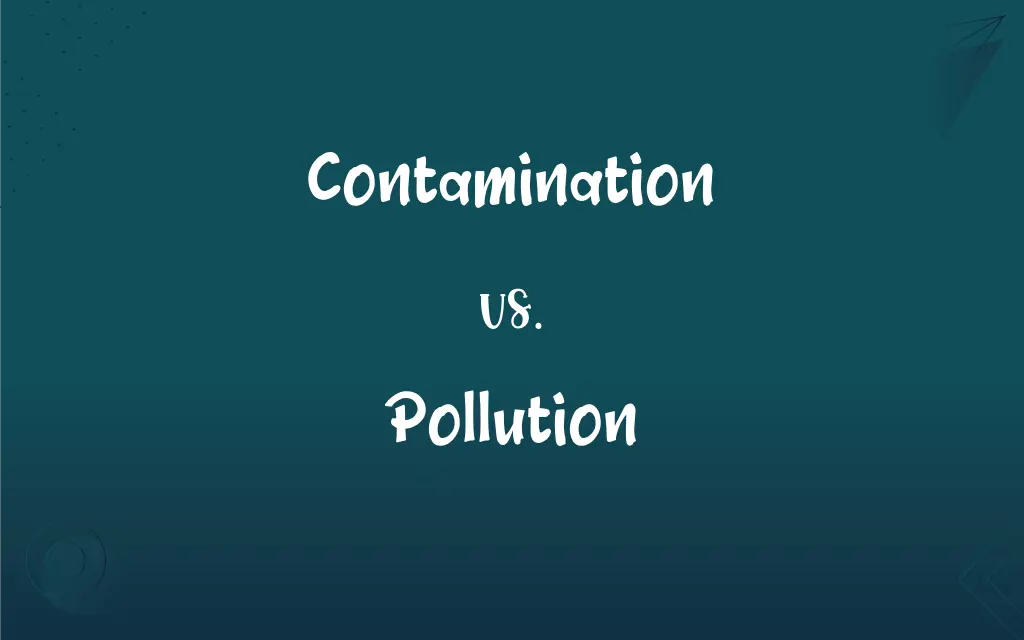Contamination vs. Pollution: What's the Difference?
Edited by Aimie Carlson || By Harlon Moss || Published on November 28, 2023
Contamination refers to making something impure by exposure to harmful substances, while pollution is the introduction of contaminants into the environment causing adverse change.

Key Differences
Contamination is the presence of an unwanted substance in another substance, making it impure. Pollution, however, refers to the introduction of harmful substances into the natural environment, causing potential harm to ecosystems.
Contamination often occurs in a localized area, affecting specific substances or objects. While, pollution is usually more widespread, impacting air, water, or soil on a larger scale.
The sources of contamination can be varied, including biological, chemical, or physical agents. However, pollution often arises from industrial, agricultural, or urban activities, leading to broader environmental impact.
Contamination primarily impacts the quality and safety of the contaminated object or substance. Whereas, pollution has broader environmental consequences, affecting ecosystems, wildlife, and human health.
Contamination can sometimes be contained or reversed with minimal impact. Pollution, especially on a large scale, can have long-lasting and far-reaching environmental effects, requiring extensive efforts to mitigate.
ADVERTISEMENT
Comparison Chart
Definition
Presence of harmful substances in something
Introduction of contaminants into the environment
Scope
Localized, specific substances
Widespread, environmental
Sources
Biological, chemical, physical agents
Industrial, agricultural, urban activities
Impact
Affects quality and safety
Broad environmental consequences
Reversibility
Often containable or reversible
Can have long-lasting effects
ADVERTISEMENT
Contamination and Pollution Definitions
Contamination
Contamination is the presence of an unwanted substance in another substance.
The contamination of the water supply led to a health crisis.
Pollution
Pollution is the introduction of harmful substances or products into the environment.
Air pollution is a major concern in urban areas.
Contamination
Contamination involves introducing a harmful substance into a clean environment.
The lab sample was ruined due to contamination.
Pollution
Pollution can degrade the quality of air, water, and land.
The factory emissions contributed to severe water pollution.
Contamination
Contamination refers to making something impure or unsuitable for use.
Food contamination can cause serious illnesses.
Pollution
Pollution can have detrimental effects on health and ecosystems.
The pollution of the lake disrupted the aquatic ecosystem.
Contamination
Contamination often impacts a specific area or substance.
The chemical spill led to the contamination of nearby rivers.
Pollution
Pollution often results from human activities.
Car exhaust is a significant source of pollution in cities.
Contamination
Contamination can occur through contact with pollutants or toxins.
The soil contamination was traced back to industrial waste.
Pollution
Pollution is a global issue affecting the earth's sustainability.
Reducing plastic waste is crucial to combating ocean pollution.
Contamination
The act or process of contaminating.
Pollution
The act or process of polluting or the state of being polluted, especially the contamination of soil, water, or the atmosphere by the discharge of harmful substances.
Contamination
The state of being contaminated.
Pollution
Something that pollutes; a pollutant or a group of pollutants
Pollution in the air reduced the visibility near the airport.
Contamination
One that contaminates.
FAQs
How does pollution affect the environment?
Pollution degrades the environment and harms ecosystems.
Can contamination be localized?
Yes, it often affects specific areas or substances.
What causes contamination?
Contamination is caused by the presence of harmful substances.
What are common contaminants?
Chemicals, biological agents, and physical substances.
Is pollution always caused by humans?
Mostly, though natural events can also contribute to pollution.
What is the global impact of pollution?
It leads to climate change, health issues, and biodiversity loss.
Does contamination always involve toxins?
Often, but not exclusively.
Can contamination be accidental?
Yes, it can occur accidentally or due to negligence.
Can contamination lead to health issues?
Yes, especially if it involves food or water.
Is soil contamination reversible?
It can be, but it often requires extensive cleanup.
How can individuals help reduce pollution?
By adopting eco-friendly habits and reducing waste.
Is noise considered pollution?
Yes, noise pollution is harmful to both humans and wildlife.
Can contamination be present in the air?
Yes, air can be contaminated with harmful particles or chemicals.
What long-term effects can pollution have?
It can lead to climate change, health issues, and environmental degradation.
How can pollution be reduced?
Through sustainable practices and reducing waste.
How does air pollution affect humans?
It can cause respiratory issues and other health problems.
Are industrial activities a major pollution source?
Yes, they are significant contributors to pollution.
What role does government play in controlling pollution?
Governments enforce regulations and promote sustainable practices.
Can contamination affect ecosystems?
Yes, particularly if it enters water bodies or soil.
Are all pollutants visible?
No, some pollutants like gases are invisible.
About Author
Written by
Harlon MossHarlon is a seasoned quality moderator and accomplished content writer for Difference Wiki. An alumnus of the prestigious University of California, he earned his degree in Computer Science. Leveraging his academic background, Harlon brings a meticulous and informed perspective to his work, ensuring content accuracy and excellence.
Edited by
Aimie CarlsonAimie Carlson, holding a master's degree in English literature, is a fervent English language enthusiast. She lends her writing talents to Difference Wiki, a prominent website that specializes in comparisons, offering readers insightful analyses that both captivate and inform.






































































